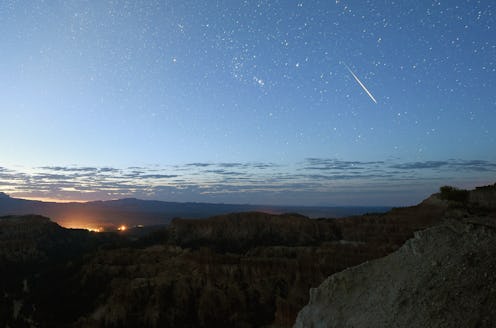For a lot of us, 2016 has been a year full of stress and disappointments, with many of us looking forward to it finally coming to a close. It's worth pointing out, however, that there are tons of awesome things still left in 2016 — including the Geminid meteor shower. These meteors are known for being seriously bright, and let's be real: We could all use some pretty lights in the night sky to get us through these stressful times.
Luckily for us, the Geminid meteor shower is not far off. According to astronomy website EarthSky, the Geminid meteor shower is expected to start in mid-December, with a peak night on Dec. 13 and going through dawn of Dec. 14. There's hope that the nights before and after the meteor's peak will be lovely, as well!
Generally speaking, the Geminid meteors tend to be harder to see in the early evening; they're actually best visible late at night, around 2 a.m. local time. As is the norm with more star-gazing, you'll want to make sure you're in a good viewing location for the shower. Aim for places you have an unobstructed view of the sky and try to find places that are free of pollution. As a note, this shower will be most visible for those of us in the Northern Hemisphere, though it will be visible in the Southern Hemisphere as well.
To see the Geminid meteor shower, you don't need any special equipment, which is awesome. As EarthSky suggests, it's a good idea to give yourself at least an hour of viewing time, because it can take a solid 20 minutes for your eyes to adjust to the darkness.
If you're a history buff, you'll likely be interested in knowing why the Geminid meteor shower has its name. According to Time and Date, when looking at where Geminid meteors come from, you'll find yourself going back to the Gemini constellation — that's actually why the meteor shower has the name that it does. But if you're not great at finding constellations, don't worry! You shouldn't need to actually locate the Gemini constellation in order to pick out the meteors. The meteors should cross the sky in a good variety of directions and intersect different constellations, so you aren't out of luck if you miss certain areas.
Now, according to NASA, there is a chance a full moon will outshine much of the Geminid meteor shower this year. The idea is that if the moon is super bright, the meteors may pale in comparison, so even if they're shooting, they'll be difficult to see. However, this isn't a guarantee! It's best to keep a close eye on predictions and still give it a shot, as the Geminid meteor shower is known for being reliable and awesome.
Happy stargazing, everybody!
Images: Giphy (2)
